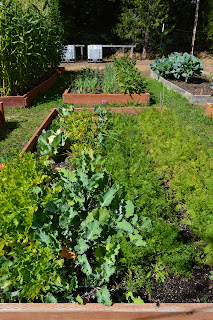Planning Your Garden
Now is the time to plan your spring and summer gardens. Begin
by browsing through your favorite seed catalog and select the varieties you
want to grow. It is important to source your seeds from a local supplier to
ensure the seeds are perfect for your particular climate and have resistance to
disease in your area. Here in the Willamette Valley of Oregon, I have the best
results with seeds from Territorial
Seed Company. Next, decide on the number of plants of each variety. Then
sketch the layout of your garden including the placement of the plants. The
following table details the spacing requirements for some of the most common
vegetable varieties.
|
Planting Guidelines
|
||||
|
Variety
|
Distance Rows (Inches)
|
Distance Plants (Inches)
|
Quantity per Person
|
|
|
Broccoli
|
24
|
12 – 18
|
5 plants
|
|
|
Brussel’s
Sprouts
|
24
|
12 – 24
|
5 plants
|
|
|
Carrots
|
12
|
1 – 3
|
10’ row
|
|
|
Cabbage
|
24
|
12 – 18
|
5 plants
|
|
|
Cauliflower
|
24
|
14 – 24
|
5 plants
|
|
|
Corn
|
24
|
9 – 15
|
25’ row
|
|
|
Cucumbers
|
48
|
12
|
10 – 15’ row
|
|
|
Onions
|
12
|
2 – 4
|
10 – 20’ row
|
|
|
Parsnip
|
18
|
3 – 6
|
5 – 10’ row
|
|
|
Peas
|
12
|
1 – 3
|
50 – 100’ row
|
|
|
Potatoes
|
30
|
9 – 12
|
50’ row
|
|
|
Pumpkin
|
60
|
36 – 60
|
1 hill
|
|
|
Squash,
Summer
|
60
|
24 – 48
|
1 hill
|
|
|
Squash,
Winter
|
60
|
24 – 48
|
3 – 5 hills
|
|
|
Swiss
Chard
|
18
|
3 – 6
|
5’ row
|
|
|
Tomato
|
30
|
12 – 24
|
5 plants
|
|
|
|
|
|
|
|
|
Specialty Varieties
|
||||
|
Variety
|
Distance Rows (Inches)
|
Distance Plants (Inches)
|
||
|
Beets
|
12
|
2 – 4
|
||
|
Endive
|
18
|
8 – 12
|
||
|
Kale
|
18
|
18 – 24
|
||
|
Lettuce
|
15
|
10 – 15
|
||
|
Radish
|
12
|
1 – 2
|
||
|
Salsify
|
18
|
2 – 4
|
||
|
Spinach
|
15
|
2 – 6
|
||
|
Turnips
|
15
|
2 - 6
|
||
SCHEDULE
Now you are ready to develop your schedule. You need to
determine what the average last frost date for your area. The National
Climate Data Center is a resource to determine average last frost date.
Simply select the State in which you reside and a PDF will open with a table
full of information. On the left, is a list of cities – find the one closest to
you. The next column has the probability of frost during (90, 50, and 10%) for
the listed date. You will use this information to plan when you need to start
the seeds and when to plant the seedlings outside. The following table has the
planting timeline for some of the most common varieties.
|
Planting
Timeline
|
||
|
Key: Before Last Frost (BLF) /
After Last Frost (ALF)
|
||
|
Plant Variety
|
Start Seeds
|
Plant Out
|
|
Marigold
|
10 weeks BLF
|
AFL
|
|
Sunflower
|
10 weeks BLF
|
AFL
|
|
Black-eyed
Susan
|
10 weeks BLF
|
AFL
|
|
Artichoke
|
8 weeks BLF
|
AFL
|
|
Brussel’s
Sprouts
|
8 weeks BLF
|
AFL
|
|
Broccoli
|
8 weeks BLF
|
AFL
|
|
Cabbage
|
8 weeks BLF
|
AFL
|
|
Cauliflower
|
8 weeks BLF
|
AFL
|
|
Zinnia
|
8 weeks BLF
|
AFL
|
|
|
|
|
|
Celery
|
6 weeks BLF
|
2 weeks AFL
|
|
Eggplant
|
6 weeks BLF
|
2 weeks AFL
|
|
Pepper
|
6 weeks BLF
|
2 weeks AFL
|
|
Tomato
|
6 weeks BLF
|
2 weeks AFL
|
|
Lavender
|
6 weeks BLF
|
AFL
|
|
Basil
|
6 weeks BLF
|
2 weeks AFL
|
|
Sweet
peas
|
4 – 6 weeks BLF
|
2 – 3 weeks AFL
|
Now that you have a good plan complete with schedule, you
are ready to order your seeds and start planting. You will want to use clean
nursery pots, loose soil, and quality seeds. Follow the seed planting depth
directions on the seed package. MAKE SURE TO LABEL THE POTS! Once seed is in the soil, gently press the soil
down to make contact with the seed. Lightly sprinkle / mist water over soil to
moisten – DO NOT WATER WITH TOO MUCH FORCE – YOU DO NOT WANT TO WASH AWAY THE
SEED. After the initial watering, it is best to water the seedlings from the
bottom – this will prevent disturbing the delicate roots and help prevent
dampening off. Place the nursery pots in a warm, brightly light area (a window
or under a fluorescent light.) Check on the seedlings regularly – at least once
a day – however I suggest checking on them 2 -3 times a day when the seeds are
just starting to sprout – especially if the area gets hot. DO NOT LET THE SEED
SPROUTS DRY OUT.
Be Patient!
It takes about to 2-weeks for most varieties to
sprout. (Some flower varieties take 4-6 weeks!)
Have fun!




Comments
Post a Comment